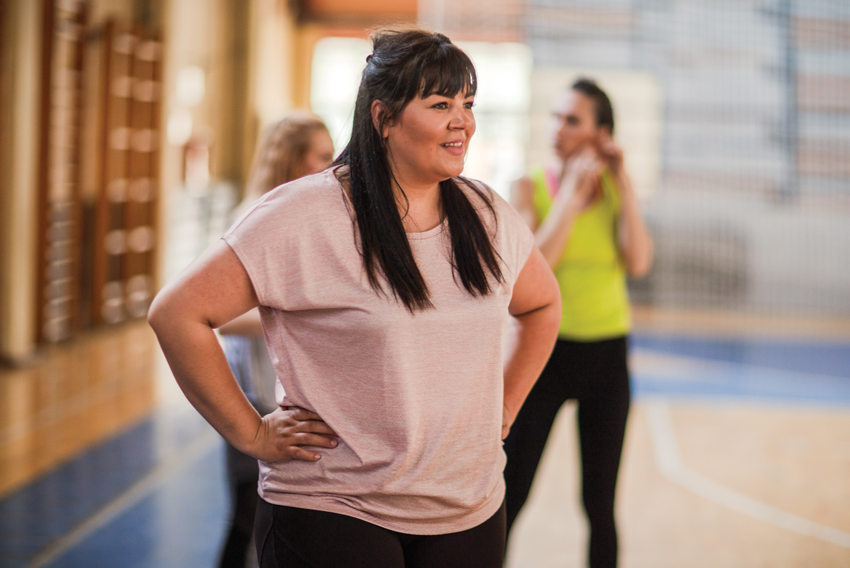Reprinted from the Nourishing and Moving Our Bodies issue of Visions Journal, 2023, 19 (1), pp. 35-37

In my mid-thirties I joined a modern dance class specifically for large people. I was a dancer with “Big Dance,” run by the Victoria, BC, choreographer Linda Raino, and later, for ten years, the Big Dance troupe. That was 30 years ago, and in the 20 years since, I have had time to reflect on all that being a dancer gave me.
I learned to embrace my body as it is and for what it can and cannot do. Rather than worrying about fitting into societal norms, through dance I got to explore grace and expression through movement and stories. Not only did this experience fill me with joy while dancing, but it also affected my mental health. And those effects lasted long after leaving behind the safety of the studio, the pleasures of being part of a dance community and the ecstasy of performing on a stage. I became confident in my own skin—and still am.
First moves
My journey started with the seemingly endless climb up three flights of stairs to the dance studio and that first timid step onto the dance floor. My first year, Big Dance class was one hour per week on Friday evenings, after which we would go for coffee and share our histories of being fat. We formed a core peer group of about eight.
Over our first few years the classes got longer, we got better and we were asked to perform at a local community centre—a raucous routine to k.d. lang’s “Big Boned Gal.” We were a hit! That’s when we started thinking of ourselves as a dance troupe and our dance classes, rehearsals and notoriety increased.
Rather than we large folk feeling like the “handicapped” group in the school, we were now an intriguing challenge for well-known choreographers who had never worked with our body type. I found myself in the studio six days a week, and dance changed me. It helped me take ownership of my self-esteem and redefine what it means to be beautiful regardless of size or shape. I also realized that my mental health was, and is, inextricably linked to how I view and accept my body.
That said, dancing with a fat-friendly troupe wasn't all sunshine and roses. I faced a lot of social ridicule from outsiders who didn't understand what we were doing. We dancers were dashing people’s expectations that we couldn’t be graceful or athletic, or that we wouldn’t contribute anything significant to the world of dance. We were sensitive to criticism because we went against well-established conventions that all dancers should be thin and willowy. On the other hand, as a group, we were more immune to people’s opinions. Safety in numbers!
It can be hard to confront this kind of judgement head-on, but every body can be expressive, conveying beauty and power. Every body deserves love and respect. The experience gave me the courage to speak out against body shaming messages that lead to dysmorphia, and to instead support fat advocacy. I learned I could push back against ideas of “normal” behaviour that try to dictate how people, particularly women, should look, act and simply occupy space.
As Lynda was fond of saying, “No pee-pee steps.” Reach and move as far as you can—take up space! So we did.
Training body awareness
I developed great respect for training properly. My knowledge of my own body became more sophisticated. I knew what foods to eat and what not to. I discovered I had an intolerance for dairy, wheat, nightshades and several other foods. I felt much better during class and would not seize up afterwards when I took them out of my diet. At that time, there was very little research on dancers of size to help guide us. (Of course, dancers would be thin, right?) So as a group, we investigated what affected our health and performance and what would help in body maintenance and repair.
Often, people make flash judgements about others who are considered fat: that they are lazy, unintelligent, not sexual and cannot control their eating or eat poorly. Well, we weren’t lazy, ate extremely well, were professionals in our day jobs and found we had a lot to convey in terms of sexuality and sensuality.
Mental health pluses
I’m not alone in having experienced the positive effects of dancing with a fat-friendly troupe. Many who struggled with stress, anxiety or low mood have said that both dance and our community gave them validation and self-satisfaction. Dance turned self-consciousness and body scrutiny into consciousness of our presence in the world and body celebration.
After-class coffees became full-on potluck parties where we shared, laughed and laughed some more! We laughed at predicaments common to us but that aren’t even a thought to others. Like the care needed when sitting in a chair, particularly with arms. Or the embarrassment of taking the chair with you when you stand up again. We howled at Lynda’s expectations of us as dancers. She didn’t really grasp that our bodies couldn’t bend like a body half our circumference, turn as fast or leap about without sounding like furniture movers.
Joy on the stage
One of the most empowering experiences of my life was being onstage with my fellow fat dancers. It reminded me that we all have the right to own our truth. It took incredible bravery to step out onto that stage in front of hundreds of people, but it was worth it! I felt my own power as an athlete and a performer—something I would never have been able to do, had I not taken a chance and discovered a part of myself outside my intellectual life.
All of us know what it feels like to stand up in a room full of people and feel completely invisible. In the rare instances when these feelings creep up on me now, I remember how amazing it felt to train, socialize and dance.
May Street Productions made a documentary film called Big Dance featuring the troupe, which was a real acknowledgement of how far we had come. The film premiered in the David Lam Auditorium at the University of Victoria in 1998. The place was packed, and it became clear we were more than fat dancers. We represented so many people who feel sidelined due to social intolerance.
Carrying on the body-positive message
Today I use the knowledge I gained to help students get in touch with their bodies in class. When I feel a mass drain of energy because everybody has been sitting slumped over too long, we stand up, breathe deeply and noisily, find the expressive value of flinging our arms around, become oxygenated, then continue class.
The first time I introduce group movement in any course is the most awkward—this is not normal behaviour! But students get into the groove, and those who celebrate its value drag the more self-conscious ones along with them.
The best is movement in drawing classes. In life-drawing, especially, seeing the pose makes more sense when you have the memory of the pose in your body as you draw. Students learn that, when you draw, your whole body is engaged in the process—no pee-pee steps! The unacknowledged benefit of expressive movement during the act of drawing is also a practice of empathy. Even though I am no longer a dancer, this is how I pay it forward.
About the author
Terryl is an associate teaching professor at Thompson Rivers University in Communication and Visual Arts. She teaches art history, visual culture, drawing and curatorial studies. One area of her research is embodiment in relation to perception, imagination and art making. Her art practice includes drawing, photography, collage and film
